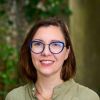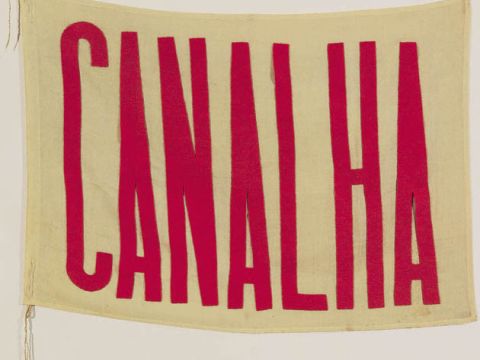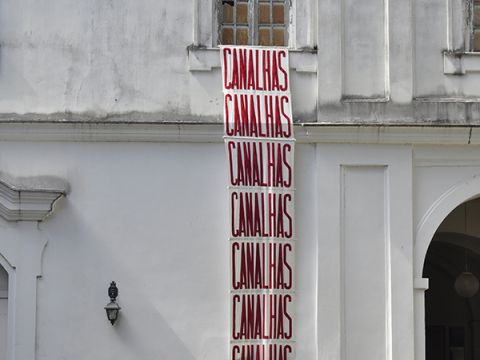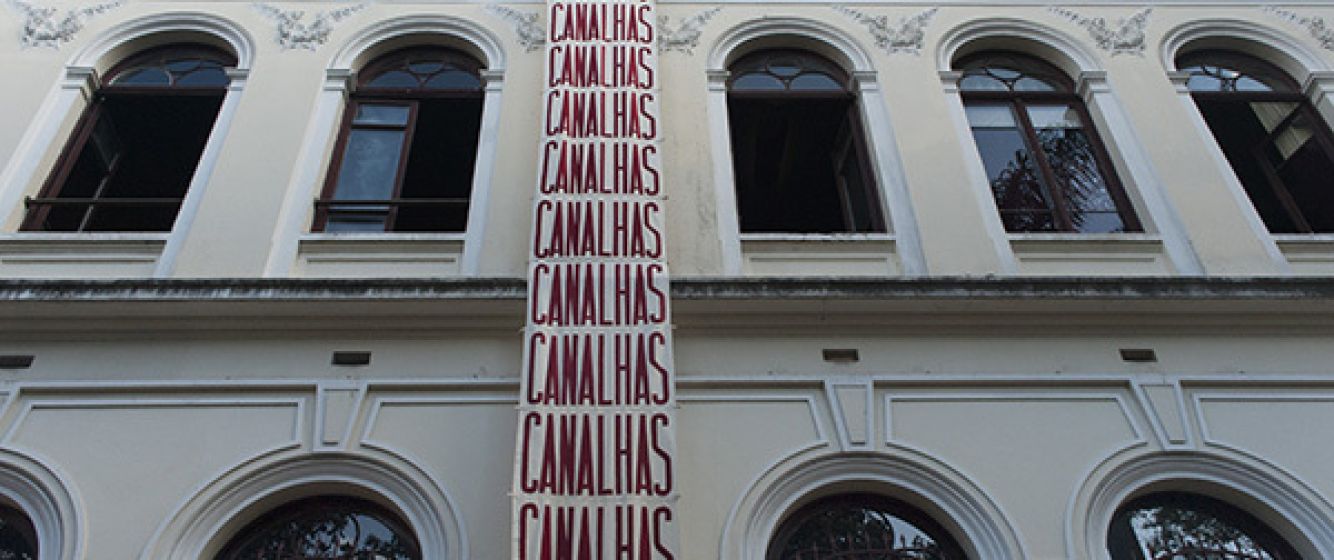
2720 Viva Maria, a collection of flags that read out the word canalhas or “scoundrels” in Brazilian Portuguese hanging on the side of the Pará State Museum in Belen, Brazil.
Credit/Source: Livia Aquino, Fundação Armando Alvares Penteado (FAAP) , 2018
Stitching Resistance in Brazil: A Conversation With Livia Aquino
Artists have long recognised flags' performative, graphic, conceptual, and political potential. For Brazilian artist, teacher, and researcher Lívia Aquino, she has used them to confront the powerlessness and indignation that swept Brazil during Jair Bolsonaro’s far-right government. Since 2017, she has conducted collaborative sewing workshops in São Paulo, revisiting and modifying Viva Maria, a famous flag by Brazilian artist Waldemar Cordeiro.
In this interview excerpt from 2020, IIAS Global Partnerships and Fellowships Coordinator Laura Erber spoke with Livia about how these workshops began, how the word Canalhas or “scoundrels” has resonated in online & offline community spaces and captures political frustrations by articulating the past within the present, and the intersection between education & learning with the creation of art.
Viva Maria or "Long Live Maria" by artist Waldemar Cordeiro. Originally presented in 1966, at the Bahia Art Biennial, during Brazil’s civic-military dictatorship (1964-1985), the flag featured the word Canalha (scoundrel) sewn in felt. The work was removed from the exhibition and has become a frequent image on Brazilian social networks.
Credit: Luciana Brito Galeria, São Paulo, Brazil
Livia Aquino's reclamation of Viva Maria, titled 2720 Viva Maria at the Pará State Museum in 2018, shown here with an additional S at the end to pluralize the word into Canalhas or "scoundrels".
Credit: Livia Aquino, Belen, Brazil, 2018
Laura: I’d love to hear your thoughts on the choice to use the plural form in the new flags, especially considering that Waldemar Cordeiro’s original flag featured Canalha in the singular. What do you think this shift to Canalhas brings to the piece, both in terms of meaning and its connection to the collective nature of the new creation process?
Livia: This work affirms an intention to transform a single work into a multiple through three gestures: the passage from the word to the plural, the multiplication of flags, and the change of the axis, from vertical to horizontal, which refers to the gesture of holding up posters at street demonstrations. It is a plural work in its proposition, made for many bodies and many hands. I am also interested in creating a relationship with the meaning of the word scoundrel when used as a system of government, a canalhocracia ("scoundrelocracy"). I believe that Waldemar Cordeiro did not intend to refer to this. Still, for me it was important to turn that word into a noun with wide political usage and meaning, it further affirmed the passage to the sense of group, plural not in the sense of diversity of course, but pointing to the fact that a “scoundrelocracy” is not made with only one scoundrel. Another aspect still is the will to dialogue/interfere graphically in the original flag, the S made me enter into the typographic logic chosen by Waldemar and, just as I approach him when I study his stitching and the shapes of the letters, I also do so in this drawing of the letter S that I introduced.
Laura: Could you share a bit about how the idea for the Viva Maria studio emerged and how the meetings unfold? How does this project align with your journey as both an artist and a teacher?
Livia: In 2016, in the troubled period of the coup negotiations and votes, Viva Maria gained the space of social networks intensely. I felt like making something out of it and went back to my observations. I started to research more about the context of its production, the Bahia Biennial in which it was exhibited, and the doubt about whether it was a unique piece or not. The idea of creating a sewing workshop for new flags came up then, with the coming together, potentializing being together around this flag and this word.
Throughout 2018, I tried to insert the work in different contexts, through edicts and conversations with various agents in the medium. With the electoral result, I decided that in 2019 I would do the workshops even outside the institutional circuit, that's when I opened my studio for the permanent workshop that happens once a month and is open to anyone who wants to come. Now in 2020, the workshops continue, returning in March, and I am looking for other spaces to expand the public and the regions of the city.
The meetings are for sewing the letters on the flag, and I generally leave the material prepared, flags ready, letters cut, and the words demarcated. Some people who have been there since the beginning know more about the process and participate in these other stages when necessary. It takes a long time, depending on each person's sewing rhythm, and this usually becomes a subject in the circle, the time it takes to make one and all the flags. I teach the stitch that Waldemar did, and each participant translates it in their way, which is why the back of the flag is so important. The work is part of an artistic practice that I resumed after my doctorate, with changes in interests and perspectives of what I used to produce. I don't see a very linear, sequential trajectory; the process of writing the thesis mobilised a lot of my relationship with the image and the text in image, and made new spaces of production open up. The teaching practice, both institutional and in the studio, in the study groups, also activated the desire for participative work at the same time that I began to understand my workshop proposals as artistic practices. I am an artist and a teacher, and these practices mix; they are embedded in me.
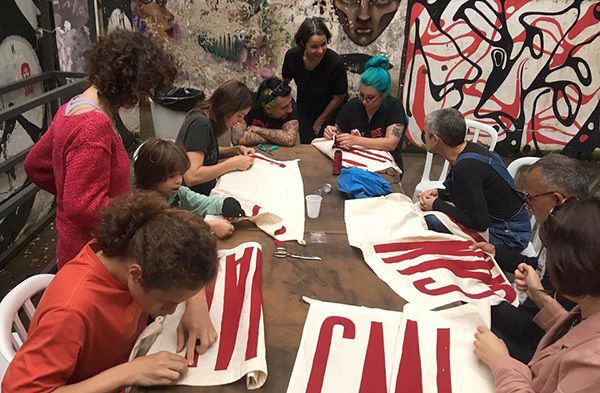
Workshop participants stitching together their own 2720 Viva Maria flags.
Credit: Livia Aquino, São Paulo, Brazil
Laura: Could you elaborate on the concept of collectivity and the sense of ephemeral community that emerges from the sewing workshops? How do these shared experiences shape the work, and are there other artistic projects or influences that have inspired you in exploring these dynamics?
Livia: I understand the presence of people in the work as a participation insofar as the proposition starts from an intent of mine and with some pre-established and non-negotiated conditions about the flag making. Those who come to sew choose this sharing and become part of the work through their stitching, the way they leave their presence in the sewing and in the conversation. This presence of the other is part of the work that does not happen without the intertwining of people. I observe with great attention the works of Monica Nador and Teresa Margolles in the way each one articulates the experience of community and collectivity. There are different ways of production, with specific approaches and contexts, and they make me reflect on 2720 Viva Maria and others that I am germinating at this moment. Producing the flags incited a desire for more and more networked productions.
Last year (2019), I started a training process in Human Rights that led me to a reading project in the women's penitentiary. It is still something new, very initial, but it is the fruit of this work and also of the observations of these artists.
Laura: How do concepts like formation, transformation, and education intersect with your understanding of art and your approach to creating it?
Livia: My work as a teacher is linked to my practice as a photographer, right at the beginning of my professional life. For many years, I taught everything related to photographic technique, camera, studio, lighting, and laboratory. This led me, in the institution where I worked, to guide projects and seek dialogues with different fields where photography is present. For this reason, I believe, I always navigate between the areas of Arts and Visual Culture, which structure thoughts for me since I did not have a traditional Arts education in college. Parallel to the work in the institutions, and also to my master's and doctorate, I have always kept study groups at the studio, focused on different research experiences, sometimes proposing reading groups, other times creating groups for the investigation of creative processes.
But I think I am building this articulation in a special way with this work of the flags. There is something inaugural about it in my process, so this understanding has been constant, in each workshop, in each participation or conversation that happens in this collective sewing space. Learning processes interest me more than education as an institutional theme. Artists' works that start from the action of moving the other towards something, of bringing the body closer, of exchange, are today the ones that motivate me the most.

Felt letters for 2720 Viva Maria on a table.
Credit: Livia Aquino, São Paulo, Brazil
Laura: Do you believe that the process of creating art, beyond the institutional or academic education of the artist, always involves some form of learning?
Livia: I think of this artistic making as being linked to an idea from Paulo Freire when he says that "the body acts and, during its attitudes, it unravels from itself and from its relations the knowledge about life. There is always the possibility of learning in the making of art, when we set out to observe and realise what actions are at play. I observe myself a lot in the making of the works, I encourage my students to observe themselves too, to look for which verbs are operating there in their projects. This is an aspect that moves me, that I think is fundamental today. We call education a lot of things, which maybe does not help us to understand it, and gets in the way of the field itself, which is itself quite complex, as it involves many agents and variables. That's why I prefer to stick to the learning processes that are present in any field of knowledge, I am mainly interested in how we learn something, this aspect of personal development that implies practices, knowledge, skills, experiences, values - a process that is present in us in almost everything we do, when we observe our cognitive and affective processes. Supervising students' projects in art puts me in direct contact with this dimension, since artistic processes are also learning processes about a practice, a doing, a body that acts on something or someone.
Laura: Is there anything specific about the Brazilian context that shapes your approach to thinking about artistic education?
Livia: I believe that a very determinant aspect of the current political context (2020), reinforced in this pandemic period, is the work relations in the field of art. The trainings, in general, take into account the construction of repertoire, the artistic practices, the processes, and so on, but little is said about this because it is a thorny subject. I have been observing very carefully the work done by groups of mediators and the educational sectors of exhibitions in museums and artistic institutions. These are workers who have been slowly organising themselves in Brazil as a collective in the work field, claiming spaces and questioning labour practices and procedures that reinforce obsolete and inadequate values and hierarchies. I don't see many other art subjects in this movement of understanding themselves as workers.
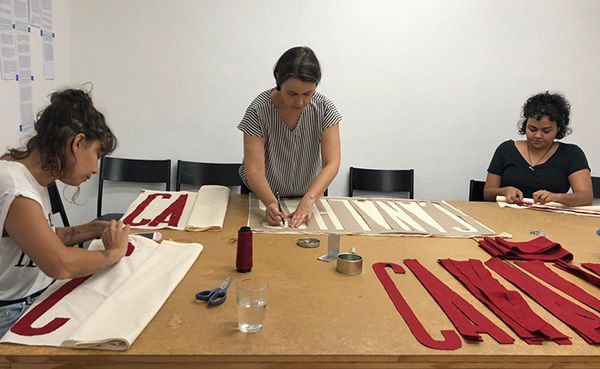
Workshop participants sewing together.
Credit: Livia Aquino, São Paulo, Brazil
Laura: When you speak about taking the flags to different spaces, beyond just responding to invitations, do you have any plans to intervene in particular public spaces or institutions? Is there a specific location where you would truly like to see them displayed?
Livia: The imagined place for this work of sewing the flags is the blind gable of the National Congress; this is my poetic exercise and also my political imagination.
I don't think much about this execution, about the feasibility of this. I work more on the construction of this narrative together with those who come to sew, those who join me for this imagination. Some people who sew in the workshops make plans, think about how to fasten the flags, propose technical solutions, and worry about the durability of the fabric outdoors. When this happens, the work gains bodies; it is a state of work that spreads. I try to build this state of work in the workshops.
Other spaces, however, have been physically opening so that the flags can be on display; so far, some institutions and movements have been partners. Each gable, facade or wall that holds the flags also fulfills a symbolic place of this great imagined occupation.
I don't have a specific focus in the case of cultural and art institutions, but without a doubt, it would be strong for me to work on the workshop beyond this activation that I can do with my network. To remain in that state of work for a longer and more constant period.
Conclusion
Aquino’s project fosters a distinct form of gathering, rooted in political indignation but housed in a space resembling domestic intimacy. Her work brings Cordeiro’s flag out of the museum and into circulation, transforming it into a dynamic site of creation. As art researcher Maria Melendi suggests, Aquino’s practice revives the protest art of the 1960s and 1970s as a "living museum," continuously reactivated and reimagined. The slow, deliberate act of sewing offers a counterpoint to the accelerated pace of catastrophe. It opens a space for unexpected encounters and shared creation, channelling collective frustration into tactile expressions of doubt and resistance.
The word Canalhas acts as a public echo of private frustrations, capturing the political affections of the moment. Aquino’s interventions articulate the past within the present, raising flags that resonate in community and civic spaces. These flags transcend the paralysing onslaught of daily bad news, creating ephemeral yet potent political communities. In their shared anonymity, participants inscribe a collective protest, directed not at a single target but at the broader uncertainties of the future.
Though Aquino lost her studio during the pandemic, her commitment remains unwavering. "When we can gather again," she says, "I will find another space." In this spirit, her project continues to weave threads of resistance, solidarity, and creative renewal.
